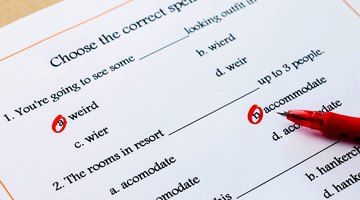Some multiple choice spelling tests are traditional -- one correct spelling among three incorrect words. Other tests have an alternative spin, such as spellings of rhyming words or fill-in-the-blank sentences where students must choose correct words in context. All of these options maintain a teacher's ability to use electronic grading systems to evaluate student performance while digging deeper into a student's spelling ability.
Right Versus Wrong Spellings
Create a multiple-choice spelling test where students have to choose which word in the list has the correct spelling. This type of test helps visual learners who spell better when they see words written out, rather than sounding them out. This testing format also works well with words that don't follow typical phonetic guidelines. For example, one of your test questions might ask which word is spelled correctly -- skiing, sking or skieing. Offer two or three incorrect alternative spellings on young elementary students' tests. On older elementary tests, give four or five multiple-choice options, including an option that says "none of the above."
Rhyming Words
Prepare a multiple-choice spelling test where students have to find the correct spelling of a word that rhymes with the word you give them. Rhyming words help students develop phonemic awareness. Students also learn to break words into syllables or root words with suffixes and prefixes. Rhyming skills teach students how to identify sequences and patterns in written words. For example, a multiple-choice question might ask what word rhymes with "flotation" -- dunation, donation or doonation?
Words in Context
Develop a spelling test that has fill-in-the-blank sentences with multiple-choice spelling word options, suggests Evelyn Farbman in her book "Sentence Sense: A Writer's Guide." These testing practices help students not only learn to spell words correctly, but also choose the appropriate spelling in the context of the sentence. For example, your fill-in-the-blank might say "She had (blank) much to eat, but it wasn't (blank) fault." The multiple-choice answers might be -- "two, you're," "to, your" or "too, your."
Unusual Plurals
Create a multiple-choice spelling test that examines your students' understanding of unusual plural spellings. For example, you might ask students to circle the plural of "foot," given the choices foots, footes and feet. Students should learn uncommon plural spellings for words, such as child, mouse, deer, tooth and fish, according to the Common Core State Standards Initiative for second graders. Students can often recognize incorrect plural spellings when they see them intermixed with correct spellings.
Related Articles
References
Writer Bio
As curriculum developer and educator, Kristine Tucker has enjoyed the plethora of English assignments she's read (and graded!) over the years. Her experiences as vice-president of an energy consulting firm have given her the opportunity to explore business writing and HR. Tucker has a BA and holds Ohio teaching credentials.











